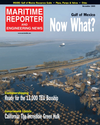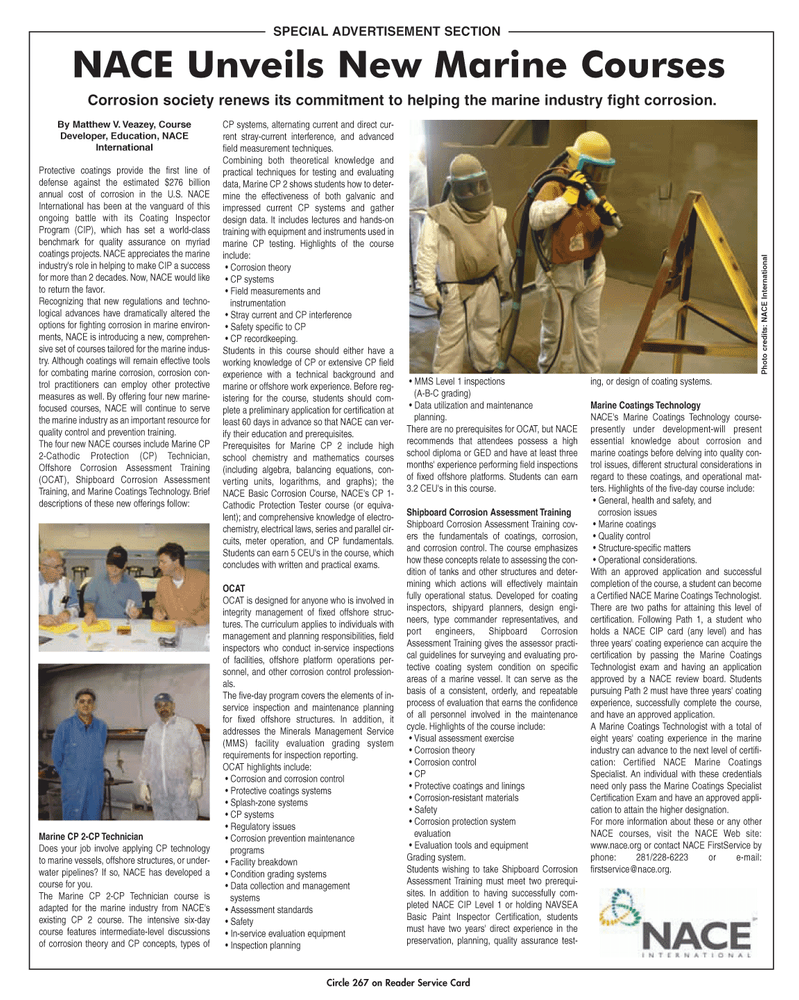
Page 22: of Maritime Reporter Magazine (November 2005)
The Workboat Annual Edition
Read this page in Pdf, Flash or Html5 edition of November 2005 Maritime Reporter Magazine
SPECIAL ADVERTISEMENT SECTION
By Matthew V. Veazey, Course
Developer, Education, NACE
International
Protective coatings provide the first line of defense against the estimated $276 billion annual cost of corrosion in the U.S. NACE
International has been at the vanguard of this ongoing battle with its Coating Inspector
Program (CIP), which has set a world-class benchmark for quality assurance on myriad coatings projects. NACE appreciates the marine industry's role in helping to make CIP a success for more than 2 decades. Now, NACE would like to return the favor.
Recognizing that new regulations and techno- logical advances have dramatically altered the options for fighting corrosion in marine environ- ments, NACE is introducing a new, comprehen- sive set of courses tailored for the marine indus- try. Although coatings will remain effective tools for combating marine corrosion, corrosion con- trol practitioners can employ other protective measures as well. By offering four new marine- focused courses, NACE will continue to serve the marine industry as an important resource for quality control and prevention training.
The four new NACE courses include Marine CP 2-Cathodic Protection (CP) Technician,
Offshore Corrosion Assessment Training (OCAT), Shipboard Corrosion Assessment
Training, and Marine Coatings Technology. Brief descriptions of these new offerings follow:
Marine CP 2-CP Technician
Does your job involve applying CP technology to marine vessels, offshore structures, or under- water pipelines? If so, NACE has developed a course for you.
The Marine CP 2-CP Technician course is adapted for the marine industry from NACE's existing CP 2 course. The intensive six-day course features intermediate-level discussions of corrosion theory and CP concepts, types of
CP systems, alternating current and direct cur- rent stray-current interference, and advanced field measurement techniques.
Combining both theoretical knowledge and practical techniques for testing and evaluating data, Marine CP 2 shows students how to deter- mine the effectiveness of both galvanic and impressed current CP systems and gather design data. It includes lectures and hands-on training with equipment and instruments used in marine CP testing. Highlights of the course include: • Corrosion theory CP systems Field measurements and instrumentation Stray current and CP interference Safety specific to CP CP recordkeeping.
Students in this course should either have a working knowledge of CP or extensive CP field experience with a technical background and marine or offshore work experience. Before reg- istering for the course, students should com- plete a preliminary application for certification at least 60 days in advance so that NACE can ver- ify their education and prerequisites.
Prerequisites for Marine CP 2 include high school chemistry and mathematics courses (including algebra, balancing equations, con- verting units, logarithms, and graphs); the
NACE Basic Corrosion Course, NACE's CP 1-
Cathodic Protection Tester course (or equiva- lent); and comprehensive knowledge of electro- chemistry, electrical laws, series and parallel cir- cuits, meter operation, and CP fundamentals.
Students can earn 5 CEU's in the course, which concludes with written and practical exams.
OCAT
OCAT is designed for anyone who is involved in integrity management of fixed offshore struc- tures. The curriculum applies to individuals with management and planning responsibilities, field inspectors who conduct in-service inspections of facilities, offshore platform operations per- sonnel, and other corrosion control profession- als.
The five-day program covers the elements of in- service inspection and maintenance planning for fixed offshore structures. In addition, it addresses the Minerals Management Service (MMS) facility evaluation grading system requirements for inspection reporting.
OCAT highlights include: Corrosion and corrosion control Protective coatings systems Splash-zone systems CP systems Regulatory issues Corrosion prevention maintenance programs Facility breakdown Condition grading systems Data collection and management systems Assessment standards Safety In-service evaluation equipment Inspection planning MMS Level 1 inspections (A-B-C grading) Data utilization and maintenance planning.
There are no prerequisites for OCAT, but NACE recommends that attendees possess a high school diploma or GED and have at least three months' experience performing field inspections of fixed offshore platforms. Students can earn 3.2 CEU's in this course.
Shipboard Corrosion Assessment Training
Shipboard Corrosion Assessment Training cov- ers the fundamentals of coatings, corrosion, and corrosion control. The course emphasizes how these concepts relate to assessing the con- dition of tanks and other structures and deter- mining which actions will effectively maintain fully operational status. Developed for coating inspectors, shipyard planners, design engi- neers, type commander representatives, and port engineers, Shipboard Corrosion
Assessment Training gives the assessor practi- cal guidelines for surveying and evaluating pro- tective coating system condition on specific areas of a marine vessel. It can serve as the basis of a consistent, orderly, and repeatable process of evaluation that earns the confidence of all personnel involved in the maintenance cycle. Highlights of the course include: Visual assessment exercise Corrosion theory Corrosion control CP Protective coatings and linings Corrosion-resistant materials Safety Corrosion protection system evaluation Evaluation tools and equipment
Grading system.
Students wishing to take Shipboard Corrosion
Assessment Training must meet two prerequi- sites. In addition to having successfully com- pleted NACE CIP Level 1 or holding NAVSEA
Basic Paint Inspector Certification, students must have two years' direct experience in the preservation, planning, quality assurance test- ing, or design of coating systems.
Marine Coatings Technology
NACE's Marine Coatings Technology course- presently under development-will present essential knowledge about corrosion and marine coatings before delving into quality con- trol issues, different structural considerations in regard to these coatings, and operational mat- ters. Highlights of the five-day course include: General, health and safety, and corrosion issues Marine coatings Quality control Structure-specific matters Operational considerations.
With an approved application and successful completion of the course, a student can become a Certified NACE Marine Coatings Technologist.
There are two paths for attaining this level of certification. Following Path 1, a student who holds a NACE CIP card (any level) and has three years' coating experience can acquire the certification by passing the Marine Coatings
Technologist exam and having an application approved by a NACE review board. Students pursuing Path 2 must have three years' coating experience, successfully complete the course, and have an approved application.
A Marine Coatings Technologist with a total of eight years' coating experience in the marine industry can advance to the next level of certifi- cation: Certified NACE Marine Coatings
Specialist. An individual with these credentials need only pass the Marine Coatings Specialist
Certification Exam and have an approved appli- cation to attain the higher designation.
For more information about these or any other
NACE courses, visit the NACE Web site: www.nace.org or contact NACE FirstService by phone: 281/228-6223 or e-mail: [email protected].
NACE Unveils New Marine Courses
Corrosion society renews its commitment to helping the marine industry fight corrosion.
Photo credit s: NACE International
Circle 267 on Reader Service Card
MR NOVEMBER 2005 #3 (17-24).qxd 10/26/2005 4:23 PM Page 22

 21
21

 23
23
